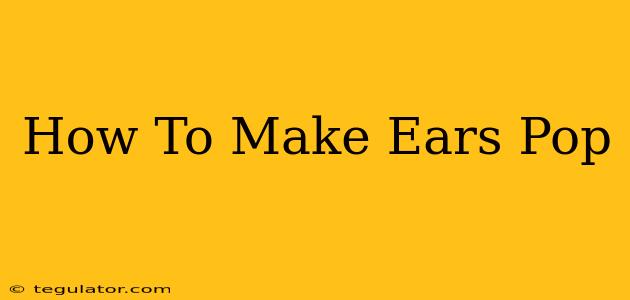Experiencing that annoying pressure in your ears, that feeling of being "plugged up"? This is often caused by a pressure imbalance between the middle ear and the surrounding environment. Learning how to make your ears pop can provide quick relief and prevent discomfort during air travel, scuba diving, or even changes in altitude. This comprehensive guide explores several safe and effective techniques.
Understanding Ear Pressure
Before diving into the techniques, let's briefly understand why our ears pop. The Eustachian tube, a small canal connecting the middle ear to the back of the throat, is responsible for equalizing pressure. When the pressure outside your ear changes (like ascending in an airplane), this tube can become blocked, leading to that uncomfortable pressure. Making your ears "pop" is essentially the act of opening this tube to equalize the pressure.
Safe and Effective Methods to Make Your Ears Pop
Several methods can help open your Eustachian tubes. Here are some of the most common and effective techniques:
1. The Valsalva Maneuver
This is the most well-known technique and often the most effective. Here's how to do it:
- Pinch your nostrils closed.
- Close your mouth.
- Gently blow air out of your nose as if you were trying to blow your nose. Important: Don't blow too hard! A gentle effort is all that's needed.
- You should feel a popping sensation in your ears as the pressure equalizes.
Important Note: While generally safe, avoid forcefully blowing air. Overdoing it can potentially damage your eardrums.
2. The Toynbee Maneuver
This method involves swallowing to help open your Eustachian tubes:
- Pinch your nostrils closed.
- Close your mouth.
- Swallow repeatedly. You might feel a slight popping sensation as you swallow.
This technique is gentler than the Valsalva maneuver and can be a good alternative if the Valsalva maneuver is uncomfortable or ineffective.
3. Yawning
Yawning naturally opens the Eustachian tubes. Try to induce a yawn by thinking about yawning or watching someone else yawn. This can be especially helpful during slow ascents or descents.
4. Head Movements
Gentle head movements can sometimes help to open the Eustachian tubes. Try tilting your head from side to side or rotating it gently. Combining this with swallowing can also be effective.
When to Seek Professional Help
While these methods are generally safe and effective for most people, it's crucial to seek professional medical advice if you:
- Experience frequent or persistent ear pressure.
- Have severe ear pain.
- Experience ear popping that doesn't provide relief.
- Notice any discharge from your ears.
- Have a history of ear infections.
Ignoring persistent ear pressure can lead to more serious issues. Consult an ENT specialist (Ear, Nose, and Throat doctor) for proper diagnosis and treatment.
Preventing Ear Pressure
While you can't always prevent pressure changes, you can minimize the discomfort by:
- Staying hydrated: Dehydration can thicken mucus, potentially blocking the Eustachian tubes.
- Avoiding air travel if you have a cold or sinus infection: This can worsen the pressure imbalances.
- Chewing gum or sucking on hard candy during ascent and descent: The swallowing motion can help equalize pressure.
By understanding the causes of ear pressure and employing these simple techniques, you can effectively manage and alleviate that uncomfortable "plugged" feeling in your ears. Remember to listen to your body and seek medical attention when necessary.

